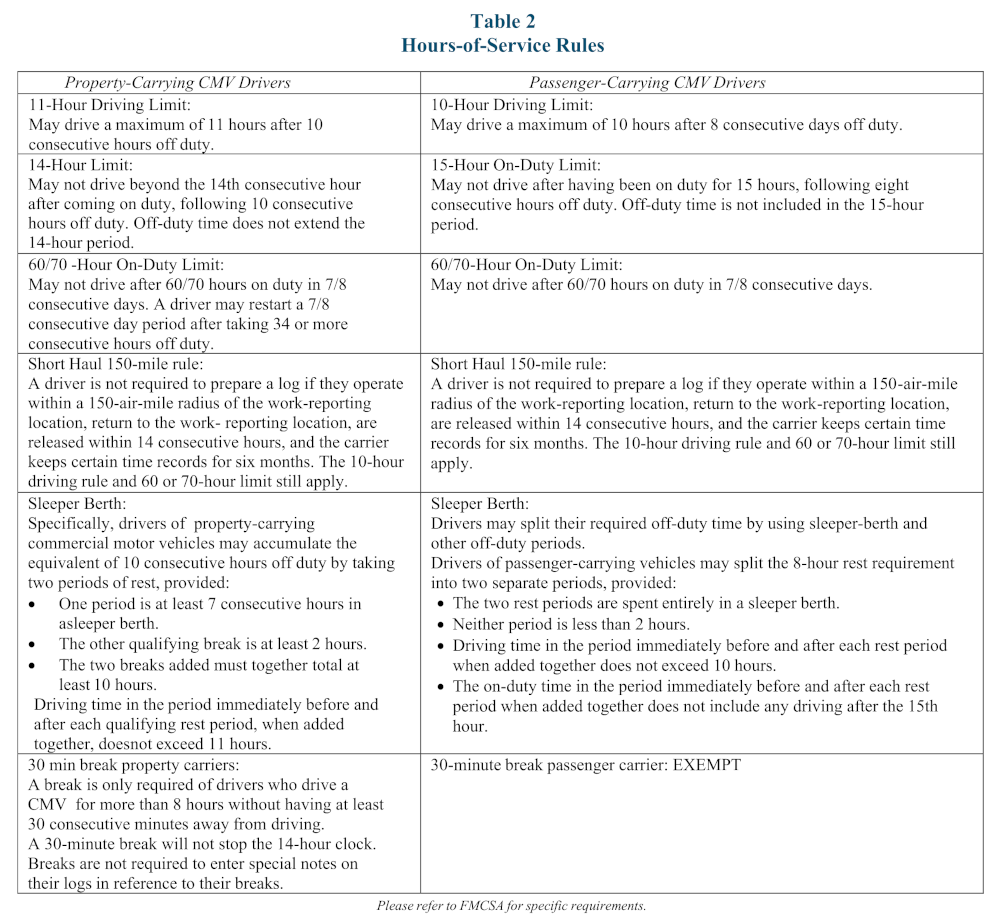
Preparing for a Dot Audit
By Alexander Ritchie and Georg Marcum
Whether a company utilizes a fleet of trucks or has just one commercial vehicle, the anticipation of a Department of Transportation (DOT) safety compliance audit can be a nerve-wracking experience – if you are not prepared. The best way to pass a DOT audit is to be certain that you are in compliance in the first place and that the company’s management team understands the regulations to which they are subject and what records the DOT expects to see.
Staying on top of those regulations is more important than ever after the Federal Motor Carrier Safety Administration (FMCSA) deployed an updated enforcement and compliance model that targets the safety problems of both motor carriers and their drivers to reduce commercial motor vehicle-related crashes and fatalities. The Comprehensive Safety Analysis 2010 (CSA 2010) establishes a new nationwide system for making the roads safer for motor carriers and the public alike. It also creates a new Safety Measurement System (SMS) that measures the previous two years of roadside violations and crash data. With SMS, every inspection counts, not just out-of-service violations, and both driver and carrier safety performance are monitored. These “investigations” are examinations carried out by a certified Safety Investigator (SI) on individual motor carriers. The goal of these investigations is to evaluate compliance with the Federal Motor Carrier Safety Regulations (FMCSR) and/or Hazardous Materials Regulations (HMR).
The Safety Measurement System considers:
- The number of safety violations and inspections
- The severity of applicable violations or accidents
- The surrounding time frame
- The number of vehicles a carrier operates, and the amount of miles traveled
Additionally, Acute and Critical Violations found during FMCSA investigations are used to organize the SMS data into seven Behavior Analysis and Safety Improvement Categories (BASICs):
- Unsafe Driving
- Crash Indicator
- Hours-of-Service
- Vehicle Maintenance
- Controlled Substance/Alcohol
- Hazardous Materials Compliance
- Driver Fitness
BASIC Intervention Thresholds
 The SMS groups carriers by Behavioral Analysis and Safety Improvement Categories (BASIC) with other carriers that have a similar number of safety events (e.g., crashes, inspections, or violations) and then ranks carriers and assigns a percentile from 0 to 100 (the higher the percentile, the worse the performance or level of non-compliance) to prioritize them for interventions. A subsequent on-site audit will be required, to determine if the proposed “unsatisfactory” safety rating becomes final. However, the FMCSA is more focused on “off-site” audits making it more critical that companies shift to using electronic files.
The SMS groups carriers by Behavioral Analysis and Safety Improvement Categories (BASIC) with other carriers that have a similar number of safety events (e.g., crashes, inspections, or violations) and then ranks carriers and assigns a percentile from 0 to 100 (the higher the percentile, the worse the performance or level of non-compliance) to prioritize them for interventions. A subsequent on-site audit will be required, to determine if the proposed “unsatisfactory” safety rating becomes final. However, the FMCSA is more focused on “off-site” audits making it more critical that companies shift to using electronic files.
Table 1 – BASIC Intervention Thresholds
| Basic | Passenger Carrying | Hazmat | General |
| Unsafe Driving, Crash Indicator, Hours-of-Service (HOS) Compliance | 50% | 60% | 65% |
| Vehicle Maintenance, Controlled Substances/Alcohol, Driver Fitness | 65% | 75% | 80% |
| Hazmat Compliance | 80% | 80% | 80% |
Motor Carrier Safety Rating
The motor carrier safety rating is an evaluation given to an interstate commercial motor carrier. A safety rating is determined by a DOT audit, which may be triggered in response to a request to change a safety rating, to investigate potential violations of safety regulations by motor carriers, or to investigate complaints, or other evidence of safety violations.
One of three safety ratings will be issued following a DOT audit – satisfactory, conditional, or unsatisfactory. A “satisfactory” rating means that a motor carrier has in place and functioning adequate safety management controls to meet the safety fitness standard. A “conditional” rating means a motor carrier does not have adequate safety management controls in place to ensure compliance with the safety fitness standard found in 385.5 of the FMCSR. An “unsatisfactory” rating means a motor carrier does not have adequate safety management controls in place to ensure compliance with the safety fitness standard.
The DOT accident registry is an important component in determining a company’s motor carrier safety rating. If the company has more than 1.5 reportable DOT accidents per million miles, the carrier automatically receives a “conditional” rating before the audit even starts. Depending on the findings, the carrier could receive an “unsatisfactory” rating.
The results of routine roadside truck inspections can also result in a “conditional” or “unsatisfactory” rating. When the roadside inspections result in an “out-of-service finding of over 34 percent, the carrier receives an “unsatisfactory” rating. Any HAZMAT deficiencies found during a roadside inspection also result in an “unsatisfactory” rating.
Generally, once a carrier receives an “unsatisfactory” motor carrier safety rating, the company has 60 days to write a safety management plan that addresses the deficiencies identified in the audit and explains what is being done to improve its fleet safety operations. A subsequent on-site audit will be required to determine if the proposed “unsatisfactory” safety rating becomes final. If an “unsatisfactory” rating becomes final, the carrier will be required to cease interstate motor carrier operations.
An onsite DOT audit evaluates the company’s safety performance and confirms proper and complete recordkeeping. The review also determines if the company has adequate management controls in place to ensure FMCSR compliance. A DOT audit covers four main factors – drug and alcohol testing, driver qualifications, hours of service, and vehicle maintenance.
Drug and Alcohol Testing
DOT’s substance abuse testing requirements include pre-employment drug testing (382.301), post-accident drug and alcohol testing (382.303), random drug and alcohol testing (382.305), and reasonable suspicion (382.307). A written drug and alcohol testing policy is required and is reviewed during an audit to ensure it contains all required components covered in the policy. The policy must be distributed to CDL drivers and a signed receipt from each driver must be on file and available for inspection.
The DOT auditor reviews records to determine if testing complied with regulations, tests were conducted on federal custody and control forms, and training for supervisors on “reasonable suspicion” testing was completed. To gauge whether the company’s pre-employment drug testing is sufficient, inspectors will pull the records on newly hired drivers to ensure there is proper documentation on approved DOT testing forms. If documentation cannot be provided that new drivers are being tested according to DOT regulations, the audit results will be impacted. The inspectors will also examine the previous year’s program and testing to ensure that 50 percent of the company’s drivers have been randomly tested for drugs and 10 percent for alcohol.
Driver Qualifications
 As part of the DOT audit preparation, the company should pull all driver qualification files, which contain information such as when a driver’s license will expire and safety performance files, which include forms that address a driver’s driving history.
As part of the DOT audit preparation, the company should pull all driver qualification files, which contain information such as when a driver’s license will expire and safety performance files, which include forms that address a driver’s driving history.
Also present in the files should be documentation of reference checks conducted for all new hires that indicate previous employers were contacted and asked about the new hire’s accident and safety history. The driver qualification file should also include the driver’s employment application, in the driver’s handwriting. HAZMAT drivers must also clear a background check by the FBI and other law enforcement agencies, as well as the Immigration and Naturalization Service.
There should also be evidence that every driver’s motor vehicle records (MVR) were obtained (for the previous three years) and examined as well as documentation of any driver training and testing. This includes driver certificates of violations and annual certifications. The files should also include each driver’s medical cards showing the results of their last three years of physical exams, which must be conducted by a licensed doctor listed in the national registry according to DOT regulations.
 Driver qualification files should indicate all training that the driver received, written tests on traffic regulations, and the results of company-administered road safety tests. This training should include entry-level driver training for employees with less than one year of experience in professional interstate travel. Driver safety training is generally recommended to be conducted regularly, which may include training at weekly or monthly safety meetings. Conducting a driver safety training class once a year for high-risk drivers or high-volume drivers as well as conducting ride-along observations are also recommended practices. In short, companies should be proactive about their driver’s safety performance and continually observe their performance, including providing feedback to their drivers. Insurance carriers have a vested in reducing the risk of auto liability claims for their insureds and may offer loss control services, such as driver safety training classes and/or mock DOT audits, in an effort to mitigate such risks.
Driver qualification files should indicate all training that the driver received, written tests on traffic regulations, and the results of company-administered road safety tests. This training should include entry-level driver training for employees with less than one year of experience in professional interstate travel. Driver safety training is generally recommended to be conducted regularly, which may include training at weekly or monthly safety meetings. Conducting a driver safety training class once a year for high-risk drivers or high-volume drivers as well as conducting ride-along observations are also recommended practices. In short, companies should be proactive about their driver’s safety performance and continually observe their performance, including providing feedback to their drivers. Insurance carriers have a vested in reducing the risk of auto liability claims for their insureds and may offer loss control services, such as driver safety training classes and/or mock DOT audits, in an effort to mitigate such risks.
Hours of Service
Another factor a DOT safety audit will examine is whether the company’s drivers are meeting the hours-of-service requirements and are keeping accurate and complete logbooks. The DOT expects six months of driver logs and supporting documents to be made available during the review. A carrier is expected to maintain a file (electronic or paper) for each regulated driver. The DOT examines these logs for violations of:
- Form and Manner (395.8[d])
- Hours-of-Service (395.3)
- Falsification of Logs
- Unaccounted hours (e.g., yard moves, etc.)
Form and manner are simply the information required on the driver’s log. Hours-of-service violations occur when a driver exceeds the 11-hour, 14-hour, or 60-hours in seven days or 70-hours in eight days rules (see Table 2). Falsification is checked using supporting documents that may be requested.
A log must be maintained by every driver in accordance with DOT regulations. So, make sure the drivers are filling out their logs completely and not exceeding the maximum hours allowed behind the wheel. Motor carriers are required to use Electronic Logging Devices (ELDs) when they utilize driver logs for eight or more days in a month. To satisfy this requirement several items must be on hand in a driver’s cab. These include a paper logbook to back up the ELD and an instruction card on how to use the ELD and the ELD device.

Vehicle Maintenance
Part of the DOT audit will be verifying that every vehicle and trailer a company owns and/or operates has a written maintenance record that documents the vehicle is in good repair and is regularly inspected, repaired, and maintained. This includes inspections that drivers do themselves as well as annual inspections, vehicle maintenance logs, and the qualifications of those employees conducting the inspections. Every repair or maintenance activity must be recorded – even changing the tire.
Each vehicle should have a vehicle maintenance file. In addition to containing records of all repairs, inspections, or maintenance performed on that vehicle, the file should clearly detail the following:
- Company number (or license plate number)
- Model and year
- Vehicle identification number (VIN) or serial number
- Tire size
- Owner (if not the motor carrier)
Except for annual inspections, maintenance records are required to be kept in the file for 12 months. Fourteen months of annual or periodic inspections must be maintained by the carrier. The DOT verifies that annual/periodic inspections are performed by certified inspectors. Certification is also required for anyone performing CMV brake system work.
Roadside inspection documentation should be maintained for at least one year. The DOT examines inspection forms to determine if the carrier has performed the required repairs discovered on a vehicle during a roadside inspection and that a signed inspection form was returned to the issuing agency within 15 days of the repair completion.
Remember that regardless of the rating a company has going into the audit, a successful audit, or re-audit, can wipe the slate clean. The alternatives are hefty fines, elevated insurance premiums, cessation of operations, and most importantly, endangering drivers and the public. These risks can largely be minimized by staying compliant every day.
Disclaimer
The authors provide no warranties or guarantees that an actual DOT audit will be limited to a review of the information described in this article. This article merely provides an overview of the topics that are commonly reviewed during an actual compliance review. The risk of receiving negative audit findings and auto incidents will be reduced by following FMCSA regulations and providing proper training for drivers. Consult a professional for assistance when needed.

Share This Article!

